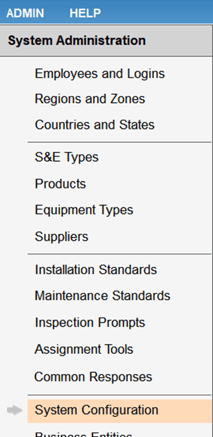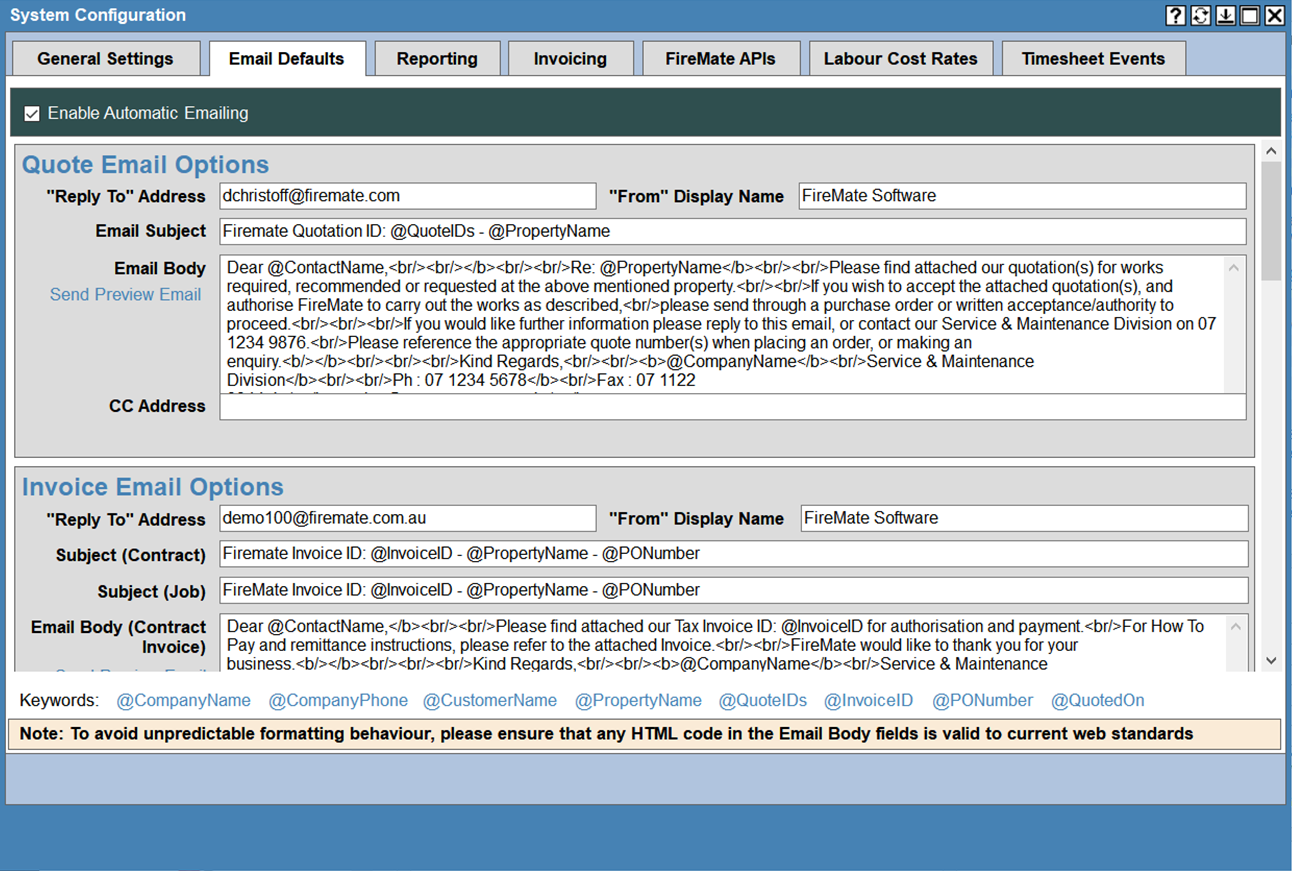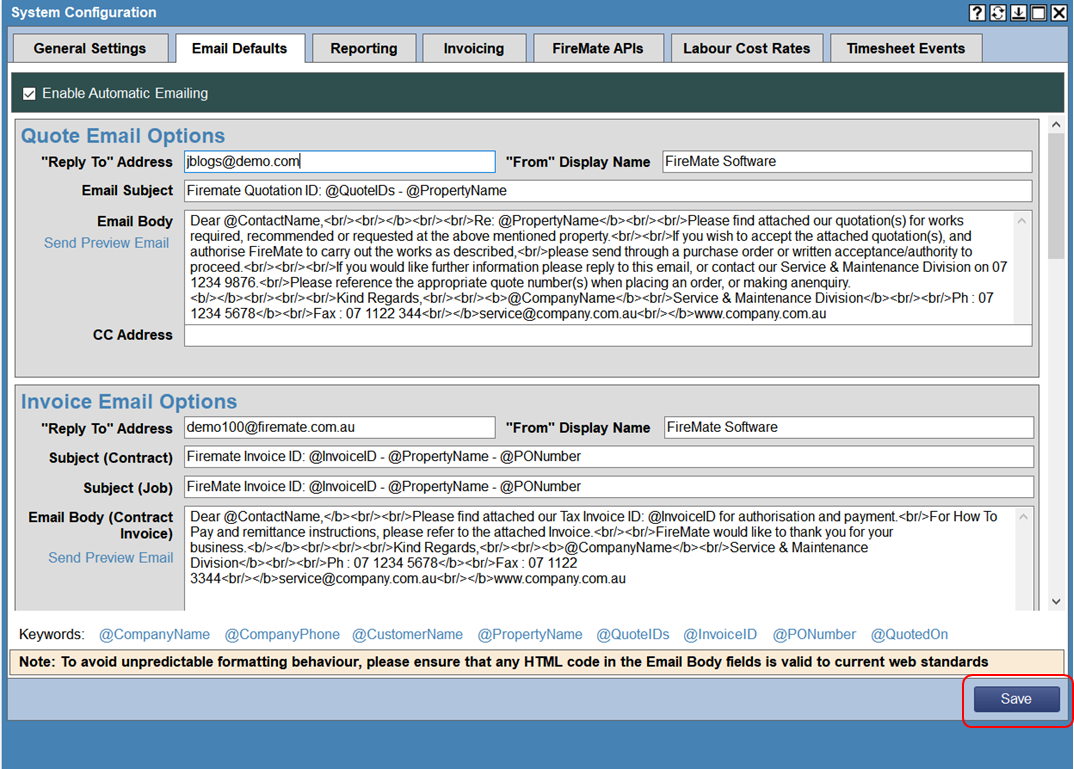Use Email Defaults to customise the content of emails sent via FireMate.
Product: FireMate Desktop
Contents
Understanding Email Defaults
FireMate has the ability to create email templates that can be used throughout FireMate. Email Defaults can be used when manually sending an email from FireMate (such as quotes and invoices), or when using the Automatic Scheduled Reporting feature.
Updates made to the templates will ensure your team is using consistent wording, and that the email includes the correct information (such as Customer Names and ID's).
How to use this feature
Locate Email Defaults templates
- From the FireMate navigation bar, select [Admin]
-
From the dropdown, select [System Configuration]

-
Select the [Email Defaults] tabs in the dialogue box

Update Email Default templates
- Locate the Email Default templates
- Scroll to the email you wish to update
-
Select the field you would like to update
- Customisable fields display with white backgrounds
-
Learn more about
Keywords here
.

-
Select [Save]

Email Default templates must be written in HTML code, but don't worry! There are plenty of HTML Code Converters online to help you out!
Customise Email Defaults
Use Keywords to prepopulate information into your Email Default templates such as Customer Name, Invoice IDs and/or Purchase Order numbers.
| Fields | Description |
| Address & Name Fields | |
| "Reply to" Address | This email address will receive any reply emails should a recipient opt to "reply" to the email they have received. |
| "From" Display Name | This is the name that will display in the "From" section of an email. |
| CC Address | These email addresses will receive a copy of the email being sent and will display in the "CC" field on the email. |
| Feedback Address | This is the email address that will receive any feedback your customers would like to send you (such as feedback on their experience with you). |
| Subject Fields | |
| Email Subject | This is the subject that will display on the email sent to a recipient. |
| Subject (Contract) | This is the subject that will display on a Contract related email sent to a recipient. |
| Subject (Job) | This is the subject that will display on a Job related email sent to a recipient. |
| Email Subject (Welcome) | This is the subject that will display in the Welcome email to users of the Customer Portal. |
| Email Subject (Password Reset) | This is the subject of the email that will display when Customer Portal users need to reset their password. |
| Body Fields | |
| Email Body | This is the text that will display in the body of the email. |
| Email Body (Contract invoice) | This is the text that will display in the body of emails containing Contract invoices. |
| Email Body (Job Invoice) | This is the text that will display in the body of emails containing Job invoices. |
| Email Body (Welcome) | This is the text that will display in the body of emails welcoming a user to the Customer Portal. |
| Email Body (Password Reset) | This is the text that will display in the body of emails when a user requests to reset their password to the Customer Portal. |
Not all fields will be available for all Email Defaults. For example, the ability to update the "Subject (Contract)" field will only be available for the Email Default that would be related to a Contract.
Keyword catalogue
| Keyword | Description |
| @CustomerName | The text entered in the "Customer Name" field |
| @ContractName | The text entered in the "Contract Name" field |
| @PropertyName | The text entered in the "Property Name" field |
| @CompanyName | The text entered as the "Trading Name" of the Business Entity or Branch (where applicable). |
| @CompanyPhone | Refers to your business phone number as displayed on either the Business Entity or Branch (where applicable). |
| @ContactName | The text entered as the "First Name" and "Last Name" of a Contact. |
| @ContactFirstName | The text entered as the "First Name" and "Last Name" of a Contact. |
| @PropRefNo | The number entered in the "Property Reference No." field on a Property. |
| @DateTimeRequired | The information entered in the "Date / Time Required" field on a Service Request or Routine Activity. |
| @DateCompleted | The date which displays in the "Completed Date" field on a Service Request or Routine Activity. |
| @ID | The number used to identify a Service Request or Routine Activity in FireMate. |
| @InvoiceID | The number used to identify an invoice in FireMate. |
| @InvoiceAmount | The amount that displays in the "Total Amount" section of an invoice, |
| @PONumber | The number used to identify a purchase order. |
| @QuotedOn | The date that displays in the "Quoted On" field of a quote. |
| @QuoteIDs | The number used to identify a quote in FireMate. |
| @QuoteAmount | The amount that displays in the "Total Amount" section of a quote. |
| @RASR | This will explain to the recipient if they are receiving communication about a Routine Activity or a Service Request. Best use with @ID. |
| @Status | The word that displays in the "Status" field of a Routine Activity or Service Request. |
| @TechName | The name which appears in the "Assigned Employee" field on a Routine Activity or Service Request. |
| @WorkDetails | The text that displays in the "Task Notes" of a Routine Activity, or the "Description" of a Service Request. |
| @Supplier | The text that appears in the "Supplier Name" field of the Supplier in FireMate. |
| @UserName | The text that appears in the "Email" field of a Customer Portal user. |
| @UserPassword | The text that was entered in the "Password" field of a Customer Portal user. |
| @FromName | The text that appears in the "From Display Name" field of an Email Default template. |
| @PortalLoginURL | The URL of the Customer Portal linked to the FireMate database. |
| @ForgotPasswordURL | The URL Customer Portal users select to reset their password to the Customer Portal. |